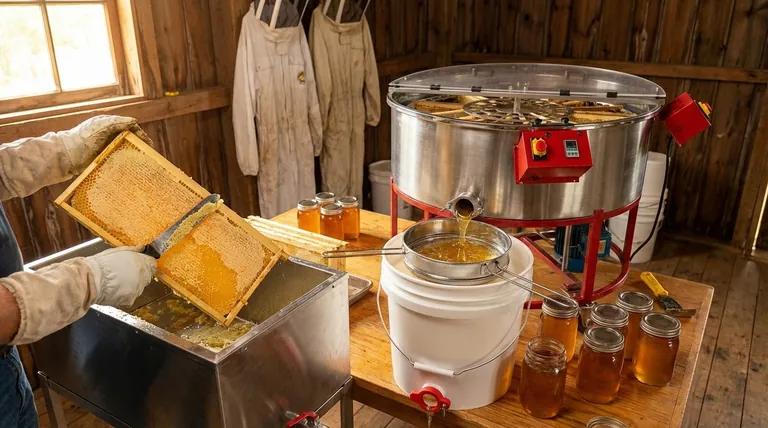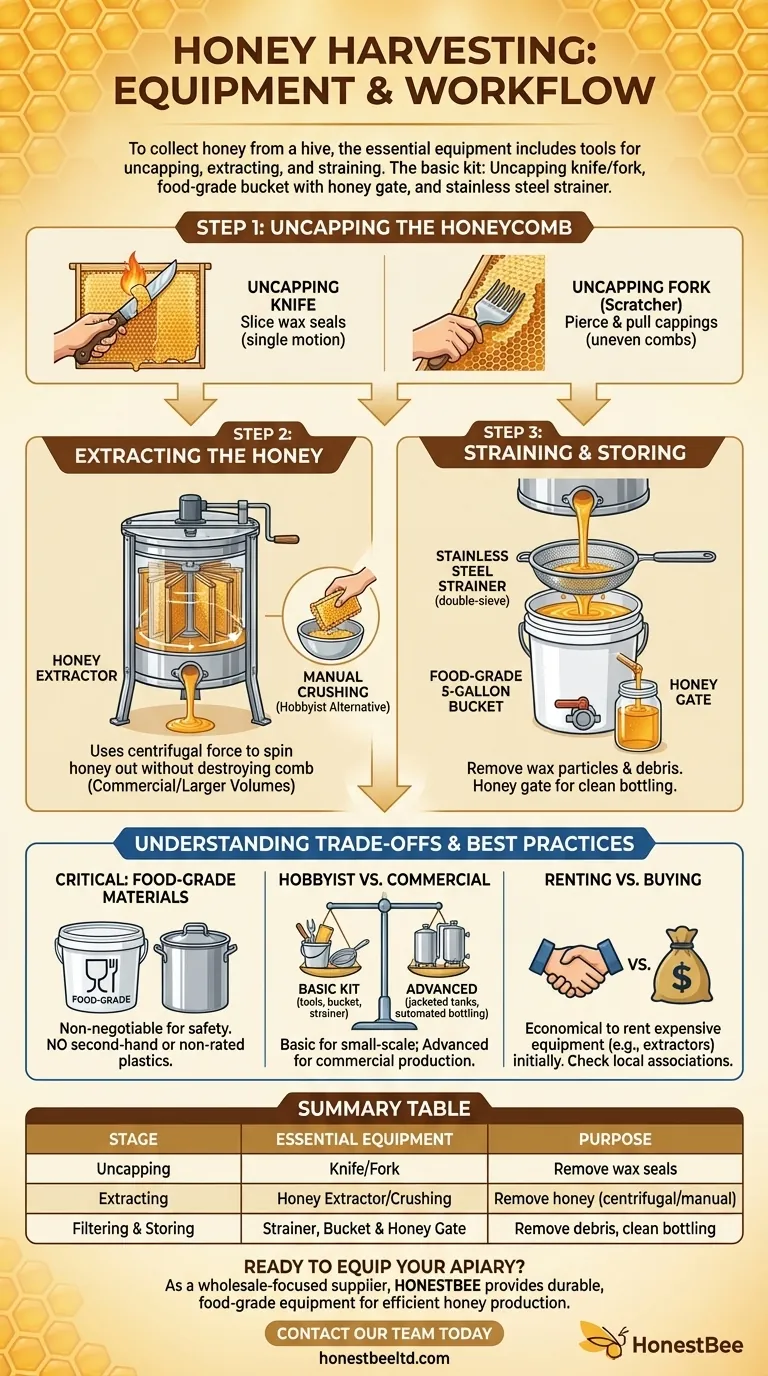To collect honey from a hive, the essential equipment includes tools for uncapping the honeycomb, a container to catch the honey, and a filter to strain it. The most basic kit consists of an uncapping knife or fork to remove the wax seals from the comb, a food-grade bucket with a spigot (called a honey gate) to collect the honey, and a stainless steel strainer to remove wax particles and other debris.
The specific equipment you need is determined by the step in the process: uncapping the comb, extracting the honey, and filtering it for storage. While a few manual tools are essential for any harvest, more advanced equipment like extractors and heaters are typically reserved for larger or commercial operations.

The Honey Harvesting Workflow: From Comb to Container
Harvesting honey is a sequential process, and the equipment for each stage is purpose-built. Understanding this workflow clarifies why each tool is necessary.
Step 1: Uncapping the Honeycomb
Before honey can be extracted, the wax cappings that bees use to seal each cell must be removed. This is the first and most hands-on step.
Your primary tools for this are an uncapping knife or an uncapping fork (also called a scratcher). Knives are used to slice off the top layer of wax in a single motion, while forks are used to pierce and pull off the cappings, which is useful for uneven combs.
Step 2: Extracting the Honey
Once uncapped, the honey needs to be removed from the comb. For a hobbyist, this is often done by crushing the comb and letting the honey drain out.
For larger volumes, a mechanical honey extractor is used. This device uses centrifugal force to spin the honey out of the frames without destroying the comb, allowing the bees to reuse it. Extractors are a significant investment, and many beekeepers rent one for their first few harvests.
Step 3: Straining and Storing
The raw, extracted honey contains particles of wax, bee parts, and other hive debris. This must be filtered out before bottling.
A stainless steel strainer, often in a double-sieve configuration with different mesh sizes, is placed over a collection container. A food-grade 5-gallon bucket, fitted with a honey gate valve at the bottom, is the industry standard. The gate allows you to easily bottle the honey without making a mess.
Understanding the Trade-offs and Best Practices
Choosing your equipment involves balancing cost, scale, and honey quality. What a commercial apiary needs is vastly different from a hobbyist's first setup.
The Critical Role of Food-Grade Materials
All containers and tools that come into direct contact with your honey must be made of food-grade plastic, glass, or stainless steel. This is a non-negotiable rule to ensure the safety and purity of your honey.
Never use second-hand plastic containers or any bucket not explicitly rated for food. Chemicals can leach from non-approved plastics and contaminate your entire harvest.
Hobbyist vs. Commercial Scale
The basic kit—uncapping tools, a bucket, and a strainer—is sufficient for a small-scale harvest.
Advanced equipment like jacketed honey tanks for heating and automated bottling machines are only necessary for commercial-level production. Heating honey can make it easier to filter and pour, but if done improperly, it can also degrade its quality. For a beginner, unheated, raw honey is the simplest and often most desirable product.
Renting vs. Buying
While it can be tempting to buy a full suite of equipment, many items are only used once or twice a year.
It is often more economical for a new beekeeper to rent expensive equipment like a honey extractor. Your local beekeeping association is an excellent resource for finding equipment rentals.
Making the Right Choice for Your Goal
Your equipment strategy should align with your immediate needs and long-term beekeeping goals.
- If your primary focus is your very first harvest: Get the essentials—an uncapping tool, a food-grade bucket with a honey gate, and a double strainer. Plan to rent an extractor.
- If your primary focus is planning for future growth: Invest in high-quality stainless steel strainers and food-grade buckets, as these core components will serve you for years.
- If your primary focus is ensuring maximum honey quality: Prioritize using only new, food-grade materials for collection and storage, and avoid the temptation to heat your honey.
Equipping yourself correctly transforms honey harvesting from a complex chore into one of the most rewarding experiences in beekeeping.
Summary Table:
| Harvesting Stage | Essential Equipment | Purpose |
|---|---|---|
| Uncapping | Uncapping Knife/Fork | Remove wax seals from honeycomb |
| Extracting | Honey Extractor (or manual crushing) | Remove honey from comb using centrifugal force |
| Filtering & Storing | Stainless Steel Strainer & Food-Grade Bucket with Honey Gate | Remove debris and enable clean bottling |
Ready to equip your apiary with professional-grade honey harvesting supplies?
As a wholesale-focused supplier to commercial apiaries and distributors, HONESTBEE provides the durable, food-grade equipment you need for efficient, high-quality honey production. From stainless steel strainers to honey gates and extraction systems, our products are built for scale and reliability.
Contact our team today to discuss your specific equipment needs and wholesale pricing.
Visual Guide

Related Products
- HONESTBEE 72 Frame Industrial Electric Honey Extractor for Beekeeping
- 6 Frame Manual Stainless Steel Honey Extractor Beekeeping Equipment
- 40 Frame Commercial Electric Honey Extractor for Beekeeping
- Plastic Hand Crank 2 Frame Honey Extractor Low Price
- HONESTBEE 6 Frame Three Use Electric Honey Extractor for Beekeeping
People Also Ask
- Why is preserving honeycomb integrity important, and how do automated extractors help? Boost Hive Health & Honey Yields
- What are the advantages of automated honey extractors in terms of time efficiency? Boost Your Harvest Speed
- What should a beekeeper do after extracting honey from supers? A Guide to Harvest Management
- What are the two common types of honey extractors? Choose the Right Extractor for Your Apiary
- How is honey harvested from Langstroth hives? A Guide to Efficient, Comb-Preserving Extraction



















